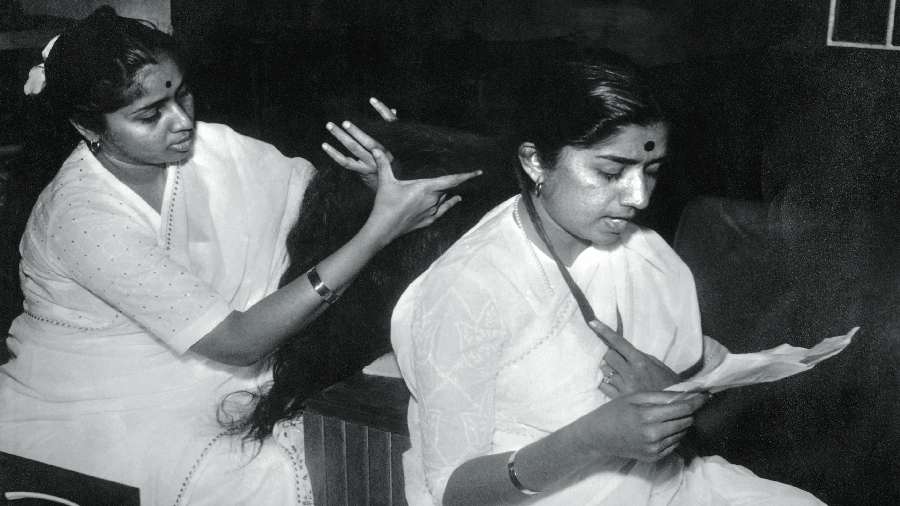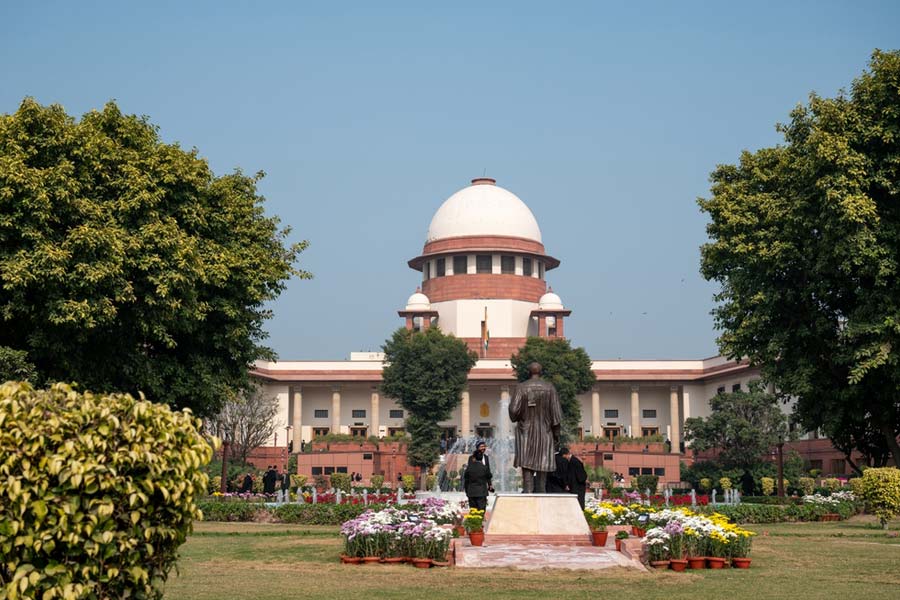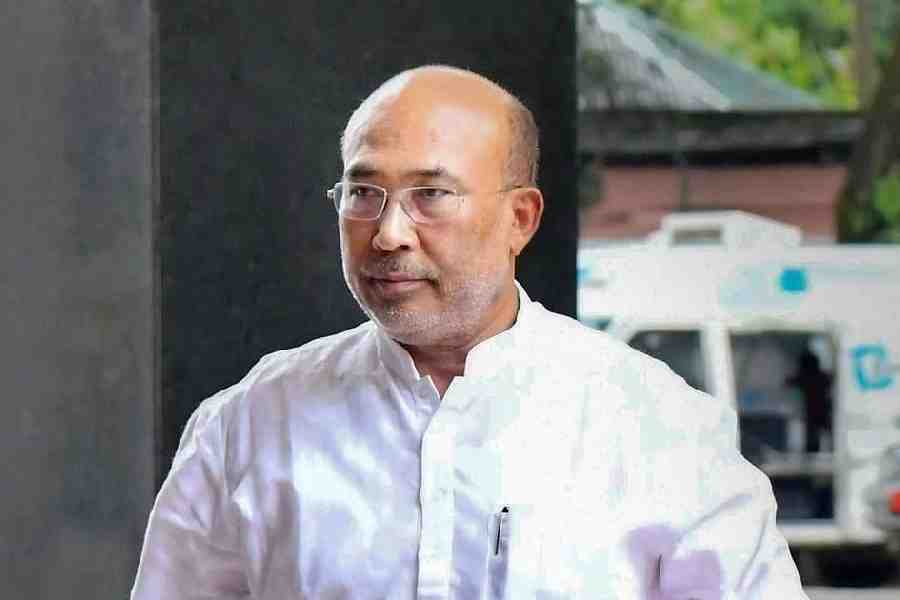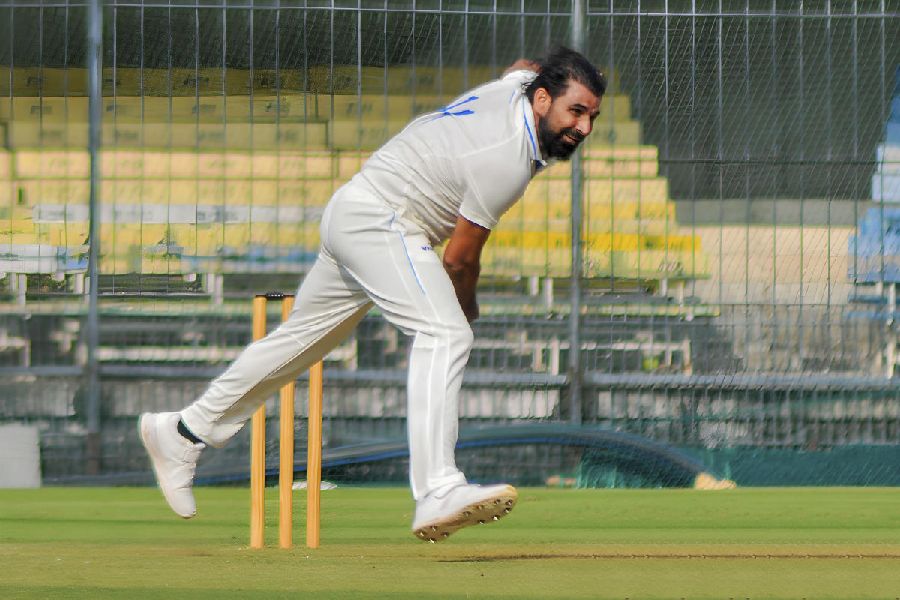Lata Mangeshkar remembers a dream that returned to her every night when she was in her early twenties. Coming home from recording two songs in the morning, two in the afternoon, and two in the evening, she would fall asleep and the dream unfurled: it is early morning and she finds herself all alone at a black-stoned temple by the sea. Unaware of the deity associated with the temple, she makes her way through the sacred space. At the back of the temple, there is a door. She opens it and sees a few steps leading from the door to the dappled water. She sits on the stone steps and the waves gently wash over her feet.
Young Lata thought nothing of the dream but when it reoccurred night after night, and for several months, she decided to share it with her mother, Shudhhamati Mangeshkar, who listened quietly to her and said: ‘God has blessed you. You will be very famous one day.’
Nasreen Munni Kabir: I read you went to school for only a day.
Lata Mangeshkar: I was at nursery first. The teacher used to write ‘Shri Ganeshji’ on the blackboard, and I used to copy it perfectly. I got 10 out of 10. While I was still at nursery, my cousin, Vasanti, was studying in the third standard at Murlidhar School. It was a Marathi medium school, just opposite our house in Sangli. And sometimes I tagged along with her. Whenever she had a music lesson, I used to listen attentively to the teacher singing.
One day, the teacher, pointing at me, asked my cousin: ‘Who is she?’ I jumped up saying: ‘I am Master Deenanath’s daughter!’ She said: ‘He is such a great singer. Can you sing?’ I told her I could sing many raags, and rattled off their names: Malkauns, Hindol, etc. She led me straight off to the staff room where all the teachers were sitting and asked me to sing. So, I sang a classical song based on Hindol. I was four or five. Then the day came for me to join the same school. Asha was about ten months old. I took her in my arms and off I went. When I entered the class, I sat down with Asha in my lap. The teacher said firmly: ‘Babies aren’t allowed here.’ I was very angry and got up. I took Asha home and never went back.
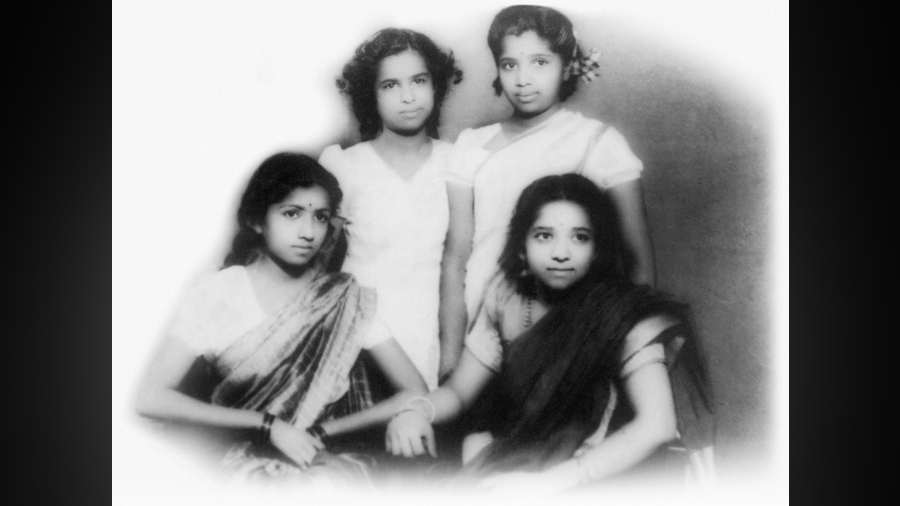
The teen-aged Mangeshkar sisters: seated are Lata (left) and cousin Malti (right). Behind them stand Meena (left) and Asha. Indore. Circa, early 1940s. Courtesy, ‘Lata Mangeshkar… in her own words’, Niyogi Books
You’re so naturally bright, God only knows what would have happened if you had been formally educated! How did you learn to read and write?
I must have been about three or four when I asked our servant, Vitthal, who was a teenager at the time, to teach me the Marathi alphabet and how to read and write the basics. I studied Marathi at home. When we were in Kolhapur, Indira, my cousin sister from Indore taught me Hindi. She was from Madhya Pradesh and spoke Hindi very well and sometimes wrote stories in Hindi magazines. But there was little time to study because we were constantly travelling with Baba’s theatre troupe. When we finally moved to Bombay, Lekhraj Sharma who taught Master Vinayak’s children, gave me further lessons in Hindi. Master Vinayak wanted me to learn the language.
A director at Prafulla Pictures, Ram Gabade, taught me English. I like reading in English and it is very necessary to know the language as it is so widely used in India. I used to read Marathi and Hindi novels when travelling to work by train. In the 1950s, a Brahmin priest called Hardikar taught me Sanskrit. I was very keen to learn Sanskrit because it improves your diction and I wanted to read the Bhagvad Gita. For short periods in my life, I had different teachers but I am mostly self-taught.
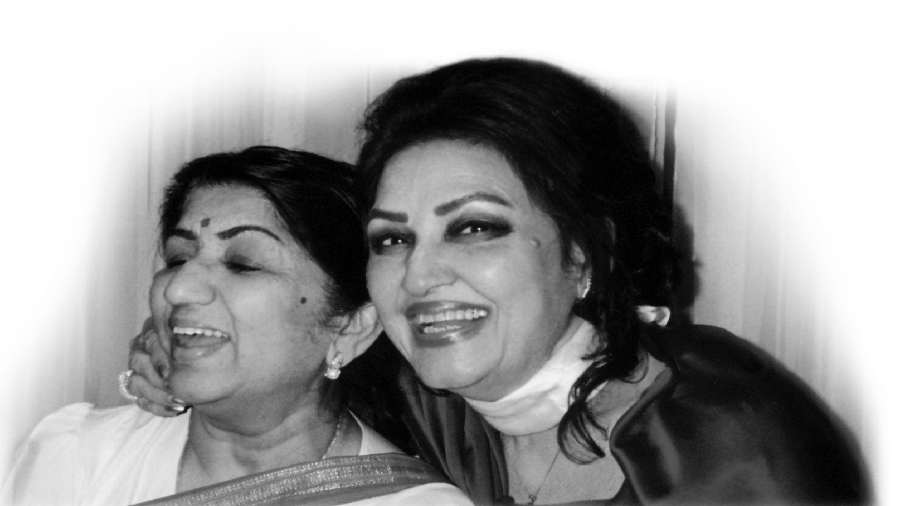
The outside world may have set them up as rivals, but in reality, Noorjehan and Lata Mangeshkar shared a warm and affectionate friendship for over 50 years. They are seen here at a party held at St James Court Hotel, London. Early 1990s. Courtesy, ‘Lata Mangeshkar… in her own words’, Niyogi Books
Was your father’s family name ‘Hardikar’?
Some people say it was Abhisheki and others say it was Hardikar. But honestly I don’t know the answer.
How many languages do you know?
[Laughs] Marathi, Hindi, Urdu, a little Punjabi, I can understand Sanskrit. I have also learned Bengali. Did you know the filmmaker Basu Bhattacharya? He was working as Bimal Roy’s assistant and when I wanted to learn Bengali, Salilda sent him to me. I tried learning Tamil too. I can read and write a little but speaking Tamil is extremely difficult.
You are quite a linguist! What triggered your interest in languages?
In 1946, I was working in a film called Subhadra. Shanta Apte, the famous Marathi actress who acted in classic films like Kunku which was called Duniya Na Mane in Hindi, was the star of Subhadra. We sang a song together and she told me she had recorded a song in Tamil. I was very young, maybe fifteen or sixteen, but when I heard her say that, I thought to myself, I must learn other languages too so I can sing in many languages.

In the late ’40s, Master Ghulam Haider had predicted that Lata Mangeshkar’s success would reach the skies. Near Kolhapur. 1949. Photo credit: Madhavrao Shinde. Courtesy, ‘Lata Mangeshkar… in her own words’, Niyogi Books
I am sure the fact you have such an ear for music, and a mastery over words, must have helped you learning other languages. You have an unusual curiosity, a thirst for knowledge and determination to better yourself. How many languages do you now sing in?
Thirty-six [both laugh]. I have sung in every Indian language, but also in Dutch, Russian, Fijian, Swahili and English. I was once performing at a charity show in Canada and 149 the organisers knew Anne Murray, the famous Canadian singer, and told her I was performing in Canada. She sent me a disc of her song ‘You needed me’ and asked me to sing it on stage. So I did.
I wonder if you know how many songs you have sung?
A gentleman from Indore, Mr. Chaurasia, recently wrote to me saying he had counted the number of songs I have sung and believed it is 28,000. Visitors come to his library and listen to his disc collection. HMV also told me they had worked out that I have sung 27,000 songs.
I am amazed you still have the use of your vocal chords after singing such an incredible number of songs! How extraordinary! You must have been close to many people in your life?
I have always felt close to people with whom talking is easy and enlightening in some way. I am thinking of my relationship with Dilip Kumarji — I am close to Saira Banu as well but our relationship is of a more formal kind. Bhalji Pendharkarji and his family have meant a lot to me. I regarded him as a father figure like Pandit Narendra Sharmaji. I shared a close relationship with Salilda, Naushad Sahib, Shankar-Jaikishan, Shrinivas Khale, Hemant Kumar, Mohammed Shafi, S.D. Burman, R.D. Burman, Sajjad Hussain Sahib, Vasant Desai, Jaidevji and Sudhir Phadke. Mehboob Sahib was dear to me, as were Sunil Dutt and Mehmood. In fact, Mehmood used to visit our home often. Not only have Majrooh Sahib, Chitragupt, Raj Kapoor and Sivaji Ganesan been close friends, but I am also very fond of their families. Other friends in the film world include Khayyam Sahib, Jatin-Lalit, the young composer, Mayuresh Pai, Padma Sachdev, Surinder Singh, Ameen Sayani, Anil Mohile, Harish Bhimani, the singers P. Sushila, Suresh Wadkar and Sonu Nigam. Among the lyricists, I have great regard for Javed Akhtar Sahib, Gulzar Sahib and the Marathi poet Grace. The celebrated Marathi poetess, Professor Shanta Shelke, was not only a friend, but also part of our family. Mr. and Mrs. Yash Chopra and I share a special bond and Yashji thinks of me as a sister. I always regarded Madan Mohan as my brother, so his son, Sanjeev Kohli, is no different than a son to me.
Extracted with permission from ‘Lata Mangeshkar… in her own voice’, by Nasreen Munni Kabir
Publisher: Niyogi Books
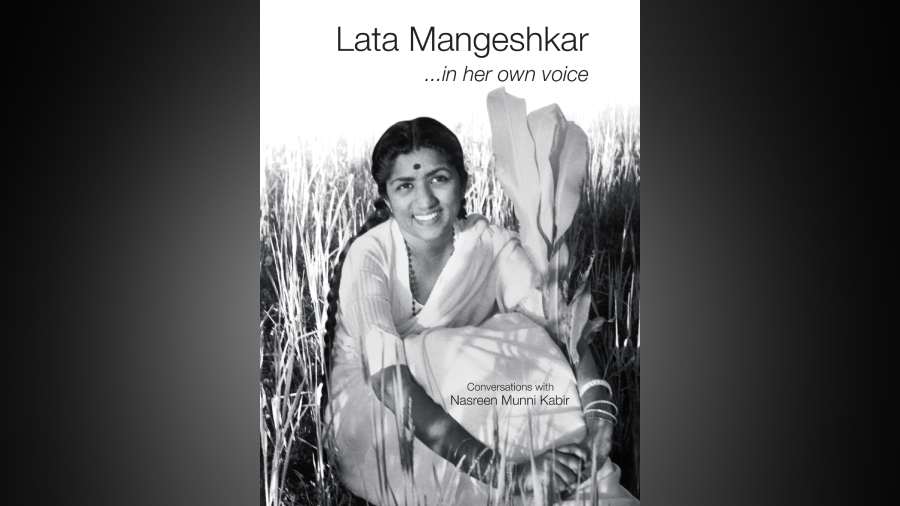
Courtesy, ‘Lata Mangeshkar… in her own words,’ Niyogi Books.
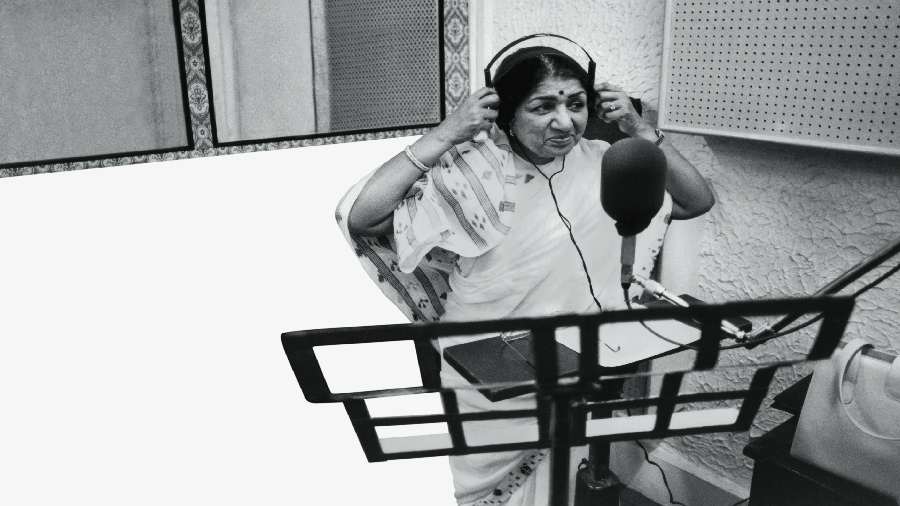
Getting ready to record a song for Yash Chopra’s Lamhe at HMV Studios, Flora Fountain, Bombay. 1991. Photo credit: Peter Chappell. Courtesy, ‘Lata Mangeshkar… in her own words,’ Niyogi Books

